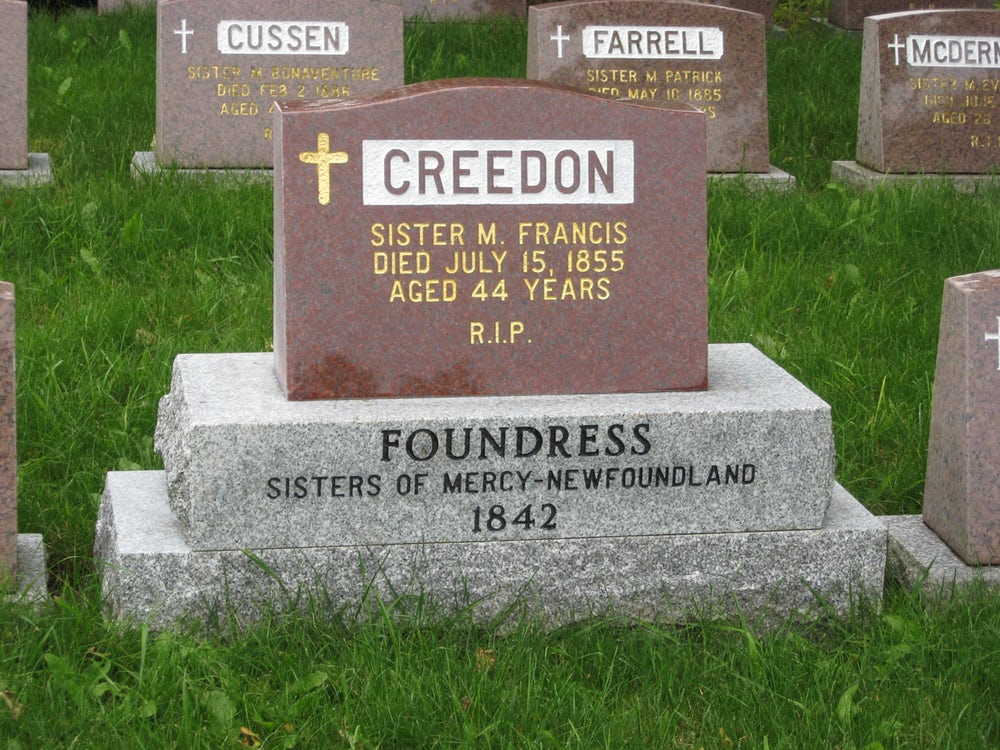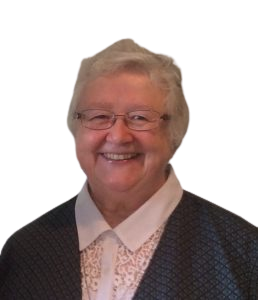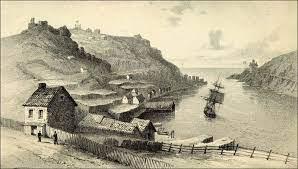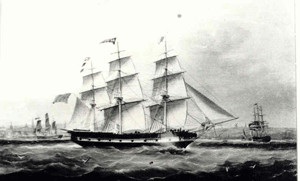On July 15 we remember with gratitude our Newfoundland Mercy foundress, Sister Mary Francis Creedon, who died on this day in 1855 at the age of 44 years.
 Francis was, in the words of Sister Kathrine Bellamy “The Steadfast Woman,” a woman who trusted, loved and lived in the midst of seemingly insurmountable difficulties, setbacks, conflict, loss and suffering, as well as in the joys of loving companionship, shared hopes and dedicated service.
Francis was, in the words of Sister Kathrine Bellamy “The Steadfast Woman,” a woman who trusted, loved and lived in the midst of seemingly insurmountable difficulties, setbacks, conflict, loss and suffering, as well as in the joys of loving companionship, shared hopes and dedicated service.
Francis was a newly professed sister living at Baggot Street when Catherine McAuley died in November of 1841. She was among the sisters named in the codicil of Catherine’s will, charged with the preservation of the charism of Mercy. This awesome trust Francis took to heart, as was evident in her whole-hearted embrace of the mission of Mercy to the people of St. John’s. In the late 1840s and early 1850s she and her sisters became familiar figures in the lanes and alleyways of St. John’s, bringing food, comfort and hope to people, many of whom lived in deplorable poverty and wretchedness.
By the Spring of 1855 the struggles and hardships of the early days of the mission, school responsibilities, regular visitation of the sick even in times of epidemics, instruction of young women who were entering the Order, opening an orphanage and an infirmary to care for sick orphans at Mercy Convent all began to take a toll on Francis’ health. However, on July 2, less than two weeks before her death, she presided at a ceremony for the reception of Anastasia Tarrahan, the first Newfoundland-born woman to enter the community.
When Francis died on July 15, only four young sisters, one of them a novice, were left to carry on the mission. Undoubtedly inspired by her spirit and example, they created a legacy of compassion, commitment and courage that has characterized our congregation to this day. For this, we are grateful to Francis Creedon and to all our foremothers in Mercy. Having received Mercy, Francis did indeed become Mercy. This is our call, our challenge, our gift…
- Read more Sisters stories documenting our Newfoundland Mercy Story
El 15 de julio recordamos con gratitud a nuestra fundadora de la Misericordia de Terranova, la Hermana Mary Francis Creedon, que murió un día como hoy en 1855 a la edad de 44 años.
Francis fue, en palabras de la Hermana Kathrine Bellamy “La Mujer Firme”, una mujer que confió, amó y vivió en medio de dificultades aparentemente insuperables, contratiempos, conflictos, pérdidas y sufrimientos, así como en las alegrías del compañerismo amoroso, las esperanzas compartidas y el servicio dedicado.
Francis era una hermana recién profesa que vivía en Baggot Street cuando Catherine McAuley murió en noviembre de 1841. Estaba entre las hermanas nombradas en el codicilo del testamento de Catalina, encargadas de preservar el carisma de la Misericordia. Francisco se tomó muy a pecho este impresionante encargo, como quedó patente en su adhesión incondicional a la misión de la Misericordia para el pueblo de San Juan. A finales de la década de 1840 y principios de la de 1850, ella y sus hermanas se convirtieron en figuras familiares en las callejuelas y callejones de St. John’s, llevando comida, consuelo y esperanza a las personas, muchas de las cuales vivían en una pobreza y miseria deplorables.
En la primavera de 1855, las luchas y penurias de los primeros días de la misión, las responsabilidades escolares, las visitas regulares a los enfermos incluso en tiempos de epidemias, la instrucción de las jóvenes que ingresaban en la Orden, la apertura de un orfanato y de una enfermería para atender a los huérfanos enfermos en el Convento de la Misericordia empezaron a hacer mella en la salud de Francis. Sin embargo, el 2 de julio, menos de dos semanas antes de su muerte, presidió una ceremonia para la recepción de Anastasia Tarrahan, la primera mujer nacida en Terranova que ingresaba en la comunidad.
A la muerte de Francisco, el 15 de julio, sólo quedaban cuatro hermanas jóvenes, una de ellas novicia, para continuar la misión. Inspiradas sin duda por su espíritu y su ejemplo, crearon un legado de compasión, compromiso y valentía que ha caracterizado a nuestra congregación hasta nuestros días. Por ello, estamos agradecidas a Francis Creedon y a todas nuestras antecesoras en la Misericordia. Habiendo recibido Misericordia, Francisco se convirtió en Misericordia. Esta es nuestra llamada, nuestro reto, nuestro regalo…
- Lea más historias de Hermanas que documentan nuestra Historia de Misericordia de Terranova


 Sister Elizabeth was nominated through the
Sister Elizabeth was nominated through the  On that day three separate colonies – the united Canadas (Upper and Lower),Nova Scotia and New Brunswick – became a single dominion, the Dominion of Canada.
On that day three separate colonies – the united Canadas (Upper and Lower),Nova Scotia and New Brunswick – became a single dominion, the Dominion of Canada. In March 2022 the UN Environment Assembly agreed to establish a global treaty to end plastic pollution and to insure a cleaner and more sustainable future for Earth and all Earth’s inhabitants.
In March 2022 the UN Environment Assembly agreed to establish a global treaty to end plastic pollution and to insure a cleaner and more sustainable future for Earth and all Earth’s inhabitants. This day was designated by the United Nations in 2001 as a way to help shine a light on the rights, needs and dreams of refugees, to commemorate their strength, resilience and courage and to mobilize global will and resources to help them.
This day was designated by the United Nations in 2001 as a way to help shine a light on the rights, needs and dreams of refugees, to commemorate their strength, resilience and courage and to mobilize global will and resources to help them. Este día fue designado por las Naciones Unidas en 2001 como una forma de ayudar a arrojar luz sobre los derechos, necesidades y sueños de los refugiados, conmemorar su fuerza, resistencia y valentía y movilizar la voluntad y los recursos mundiales para ayudarles.
Este día fue designado por las Naciones Unidas en 2001 como una forma de ayudar a arrojar luz sobre los derechos, necesidades y sueños de los refugiados, conmemorar su fuerza, resistencia y valentía y movilizar la voluntad y los recursos mundiales para ayudarles.

 More than 150 countries participate in this international day, which features a different environmental focus each year – air pollution, biodiversity loss, food security, illegal wildlife trade. This year’s theme focuses on plastic pollution. More than 400 million tons of plastic is produced every year, with approximately 20 million tons ending up in lakes, rivers and oceans.
More than 150 countries participate in this international day, which features a different environmental focus each year – air pollution, biodiversity loss, food security, illegal wildlife trade. This year’s theme focuses on plastic pollution. More than 400 million tons of plastic is produced every year, with approximately 20 million tons ending up in lakes, rivers and oceans. What must have been their thoughts as they looked upon the forbidding landscape with its towering rocky c liffs and craggy head lands ? Although they had seen poverty in Ireland, t he abject poverty of this place with its rude shacks and derelict fishing stages perched on the side of the hills, would have seared their hearts and minds. Sister Francis had lived in the colony for six years, but for Sisters Ursula and Rose the scene before them must have caused some dismay and distress.
What must have been their thoughts as they looked upon the forbidding landscape with its towering rocky c liffs and craggy head lands ? Although they had seen poverty in Ireland, t he abject poverty of this place with its rude shacks and derelict fishing stages perched on the side of the hills, would have seared their hearts and minds. Sister Francis had lived in the colony for six years, but for Sisters Ursula and Rose the scene before them must have caused some dismay and distress. ¿Qué debieron de pensar al contemplar el imponente paisaje de acantilados rocosos y escarpados promontorios? Aunque habían visto la pobreza en Irlanda, la abyecta pobreza de este lugar, con sus rudimentarias chozas y sus abandonadas etapas de pesca encaramadas en las laderas de las colinas, les habría abrasado el corazón y la mente. La hermana Francis había vivido en la colonia
¿Qué debieron de pensar al contemplar el imponente paisaje de acantilados rocosos y escarpados promontorios? Aunque habían visto la pobreza en Irlanda, la abyecta pobreza de este lugar, con sus rudimentarias chozas y sus abandonadas etapas de pesca encaramadas en las laderas de las colinas, les habría abrasado el corazón y la mente. La hermana Francis había vivido en la colonia